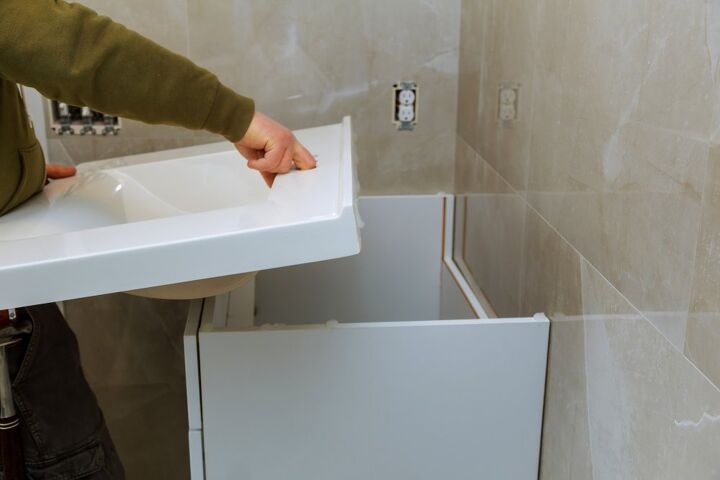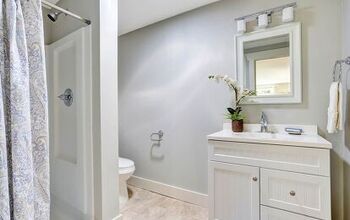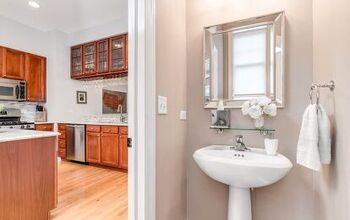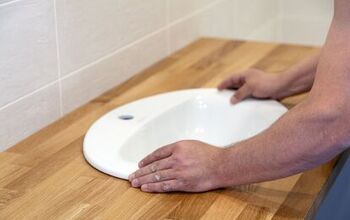How Much Does It Cost to Remove a Bathroom Vanity?

If you are doing a bathroom remodel, one of the biggest parts of the project can be removing the old bathroom vanity. Removing the old vanity can involve electrical work, plumbing work, demolition work, and cleanup of the space. As you plan your bathroom remodel, it is important to understand the cost of removing your old bathroom vanity.
On average, removing a bathroom vanity costs between $115 and $500. A plumber will charge between $150 and $300 to disconnect the water lines and drainpipes. In some areas, a disposal fee to haul away the old vanity can cost up to $90.00. The total expense for removing your old bathroom vanity can run between $115 and $890.
Do You Need Bathroom Remodeling Services?
Get free, zero-commitment quotes from pro contractors near you.

| Job Cost to Remove a Bathroom Vanity | Lower Cost Range | Upper Cost Range |
| Preparation for vanity removal (plumber) | $150 | $300 |
| Vanity removal | $115 | $500 |
| Waste Disposal Fees | $90 | $90 |
| Total Vanity Removal Costs | $355 | $890 |
Why such a Wide Cost Range for Removing a Bathroom Vanity?
Many factors affect the cost of removing a bathroom vanity from your home. Some of these factors may not affect your project. Others could impact the cost of your bathroom remodel significantly. It is important to understand the possible cost factors when estimating a remodel project.
The Size of the Vanity
Tearing out a small single sink vanity in a guest bath or a half-bath is much different than removing a double-sink vanity. The larger and more complex the vanity installation, the more costs can usually be expected. Typically, a simple freestanding small vanity costs about $115 to remove. Large built-in custom vanities can cost as much as $500.
Location Complications
The location of the bathroom in your home can contribute to the cost. A small vanity in a half-bath near an entry to the home is typically much cheaper to remove. A large bathroom vanity upstairs in a master bathroom suite involves more labor and extensive preparations raising the cost.
Plumbing and Electrical Issues
Part of the vanity removal requires that the water lines to the sink be disconnected and the drainpipe. Some contractors will handle the disconnects themselves as part of the removal costs. However, if the plumbing or electrical in the vanity is more than a few simple disconnects, you should arrange for a plumber and electrician.
In some areas, any time the electrical or plumbing system in your home is changed or repaired, a building permit is required. Be sure and check with your local building department for the requirements where you live.
Free Standing Vanities vs. Built-in Vanities
Usually, freestanding vanities are easier to remove than custom built-in vanities. Pre-built vanities may detach from the wall quickly and be removed as a whole unit. Custom built-in vanities have other issues.
Often these custom-built cabinet units are built in place and require complete demolition to remove. This vanity cabinet style can involve more time and more expense to remove cleanly and without damage to the surrounding space.
Counter Tops and Backsplash
Don’t forget the countertop and backsplash. Usually, contractors include removing the countertop with the total job cost. However, removing tile or stone backsplash material will probably incur an additional charge.
Some countertops will elevate the cost of vanity removal because of their construction and materials. Concrete countertops are heavy and require more labor to remove. Stone or quartz countertops can also present additional problems.
Site Preparation and Cleanup
A good contractor will be meticulous in preparing for the demolition of your bathroom vanity. Protection for the rest of your house is part of the job. Protecting floor coverings from the bathroom to the exterior of the home is necessary. You should expect bump pads or protection for walls and furniture. When the contractor leaves, the entire work area and the route leading to the work area should be clean and damage-free.
Can I Save Money by Removing the Vanity Myself?
Maybe or maybe not. How much you can save by removing your bathroom vanity depends a lot on your skill level. There are also the issues of costs you cannot avoid because of local conditions and regulations.
Permits and Fees
The first issue to consider is the cost of permits and fees. If your local building code ordinances require you to get a permit to perform the job, you cannot avoid those fees. If you hire someone to remove your bathroom vanity, typically, the contractor is responsible for the permits and fees. Permit fees can range from $20 to $1000, depending on your location and the extent of the project.
Plumbers and Electricians
If you aren’t comfortable disconnecting water lines, sewer lines, and electrical connections, you should hire an electrician and a plumber. In some areas, only licensed electricians and plumbers can perform these tasks. This is especially true if you must get permits for the electrical and plumbing work.
On average, plumbers charge between $20 and $36 per hour. Electricians, on average, charge between $18 and $30 per hour for their services. Plumbers typically take 2 hours to disconnect the plumbing to a bathroom vanity. The time it takes an electrician to disconnect any power to the vanity can vary, but it usually doesn’t take more than one and one-half hours.
Haul-Off and Disposal
Once you have the old vanity out of the bathroom, you must dispose of the remains. Many municipalities prohibit putting construction waste into your regular household garbage. You are left with a few options, all of which involve some costs.
- Hire a waste disposal company to come and pick up the construction waste. In general, these companies charge between $100 and $800 to do a one-time construction waste pick-up at your home.
- You can haul the debris to your local landfill site. If your vehicle is large enough and you don’t mind the chance of damage, most municipal landfills will take small loads of household garbage for free. However, construction debris and other large loads may incur a charge from the landfill. A single load to a landfill that takes construction debris can cost between $80 and $100.
- When you hire a contractor to remove your old bathroom vanity, they should include debris removal and cleanup in the estimate. Make sure this is the case before you sign any contracts. Often contractors have the equipment to haul the debris directly to the landfill and get special rates on the disposal.
Nothing is more frustrating than completing a remodel project and being left with a pile of construction debris on your driveway or lawn. On average, if you decide to remove your old bathroom vanity yourself, you can expect to incur some, if not all, of these costs.
| Costs to Remove a Bathroom Vanity Yourself | Low End | High End |
| Permits and Fees | $20 | $1,000 |
| Plumbers and Electricians | $40 | $120 |
| Waste Disposal | $80 | $200 |
Can I Reuse the Old Countertop and Sink on a new Vanity?
If you can remove the countertop and sink from the old vanity without damage, you may reuse them on a new vanity. However, you should stop and think about this decision. Several considerations may make reusing a countertop and sink a bad choice.
- Old and Dated – If your old vanity was looking old and dated, your countertop and sink are probably suffering the same look. If you are going to the trouble and expense of replacing the vanity, doesn’t it make sense to install a new countertop and sink as well?
- The Cost Factor – Reusing a countertop and sink can cost as much as installing a new countertop and sink. Refurbishing the old countertop and sink requires time and materials that all have a cost. In many instances, purchasing a pre-built vanity from the home improvement store includes a new countertop and sink. Expect to pay between $100 and $2600 for a new vanity with a new countertop and a sink.
- The Time and Trouble Issues – Removing old countertops without damaging them is requires extra time and care. This extra time and care all add up to more cost. Often, the old countertop needs reconfiguring to work with a new vanity which adds more expense. Spending dollars to pinch pennies is bad financial thinking.
You can reuse the old countertop and sink on a new vanity. We don’t recommend this unless the countertop is a special material such as granite or other stone. We also suggest hiring a professional to remove the countertop and re-install it on the new vanity if this is the case.
What Other Problems Might I Expect After the Bathroom Vanity is Removed?
Once the old bathroom vanity is removed and disposed of properly, there may be other issues. Some of the more common problems that people encounter when removing a bathroom vanity include these.
Mold Abatement
After removing the old bathroom vanity, you will often find that the back of the vanity was hiding mold issues. This is not uncommon in a bathroom where heat and humidity are present. If the mold is on the surface, it can be treated easily. However, if the mod is deep-seated and into the sheetrock or other building materials, you may need a professional to treat the problem.
Mold abatement is not a problem to be treated lightly. Mold in your home can have serious health implications. Mold abatement often costs between $13.50 and $28.50 per square foot. A small infestation behind a bathroom vanity can cost $450.
Additional Plumbing Repairs
You can find that the plumbing in your bathroom needs additional repair or replacement as you remove the old bathroom vanity. This is especially true in older homes. You may find issues such as:
- The cold and hot water shutoff valves need replacement. These small valves corrode and can become inoperative over time. Typically, a plumber will charge between $175 to $250 to do the replacement. The cost of the new valve is included in this price.
- Drainpipe plumbing for a new sink is usually the best option. In addition, the old drain connection at the wall may need an extension or replacement. The cost of repairing a sink drainpipe varies but can usually be done for $175 to $325.
Flooring and Finish Repairs
- Removing an old vanity usually leaves spaces where tile, backsplashes or wall coverings need replacement. Costs for repairing the wall surfaces before installing a new bathroom vanity can range from $100 to $2000.
- It is not uncommon for the footprint of a new vanity not to match the old vanity. This usually means the flooring in your bathroom must be repaired or replaced as part of installing a new bathroom vanity. Flooring costs for a small bathroom range from $120 to $2,500.
Don’t Forget the Faucet
Suppose you are going to the expense of installing a new vanity, a new countertop, and a new sink. In that case, a new faucet is certainly not unexpected. In general, bathroom faucets can be purchased at prices ranging from $50 to $1,000. Most people spend between $80 and $150 for a good-quality bathroom faucet.
Go With a Professional or Go it Alone?
Our recommendation on projects the size and complexity of a bathroom vanity removal is to hire a professional for the job. A professional contractor brings knowledge and experience to the project that most homeowners don’t have. In addition, hiring a professional contractor usually comes with insurance and other protections for you and your home. Lastly, you save yourself the time and hard labor that removing a bathroom vanity entails.
When the job is done, you can expect to pay a bit more, but you are left with a clean space ready for the next step, installing your new bathroom vanity.
Do You Need Bathroom Remodeling Services?
Get free, zero-commitment quotes from pro contractors near you.

The Goal – a New Look and a New Feel
In the end, the goal of removing your old bathroom vanity is to take the next step. Installing your new bathroom vanity gives your bathroom a new look and feel that can make the space more livable and add value to your home. Whether you do it yourself or hire a professional, removing the old vanity is the first step in the project.

Dennis is a retired firefighter with an extensive background in construction, home improvement, and remodeling. He worked in the trades part-time while serving as an active firefighter. On his retirement, he started a remodeling and home repair business, which he ran for several years.
More by Dennis Howard



























